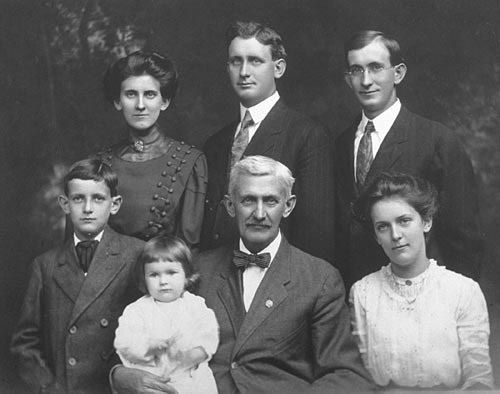Living in 2019 with the medical breakthroughs we enjoy, we can only imagine the challenges of Fountain City’s first physician who practiced medicine for over 50 years with the diagnostic techniques, treatment regimens and pharmaceuticals available at that time.
Our subject, Samuel Love Tillery, was born on April 22, 1851. He grew up on the family farm in Ebenezer and attended the local schools. We have no record of his childhood and youth but can only surmise that a boy living in Ebenezer at the time of the Civil War (1861-1865) must have seen uniformed men, cavalry horses and quartermaster wagons, probably in camps on or near the family farm.
The Battle of Campbell’s Station was fought nearby on Nov. 16, 1863, as Union Gen. Ambrose Burnside with 5,000 infantrymen and Confederate Gen. James Longstreet with 15,000 engaged in a race along Kingston Pike and parallel routes for the defenses of Knoxville. Twelve-year-old Samuel must have witnessed some of those thousands of troops as they moved toward the city during the siege of Knoxville (November and December 1863) and must have been aware of the Battle of Knoxville on Nov. 29.
Samuel evidently was a very good student since few were able to attend college during the turbulent times following the war as he did. Only a very select few were enrolled in the South’s most prestigious medical school, the University of Louisville. Its location on the Mississippi River had assisted in making Louisville a burgeoning transportation center by the 1830s. Largely due to steamboat travel, the city had grown to become one of the largest in the South. In the 1860s only New Orleans (population 169,000) and St. Louis (161,000) were larger than Louisville (68,000). By comparison, Charleston (41,000), Memphis (23,000) and Savannah (22,000) trailed far behind.
Cultural institutions developed early there and so did higher education. The Louisville Medical Institute admitted 80 students in its first class in 1837. At that early date, seven faculty members taught classes in the impressive Greek Revival building, and clinical sessions were held in the Louisville City Hospital, the city’s finest. Several of the most distinguished professors from Lexington’s Transylvania College had joined the faculty. The school’s library was one of the finest in the country with numerous volumes purchased in Europe, then the center of medical knowledge.
By 1846, the Institute had grown and had become the medical department of the newly formed University of Louisville. When Samuel, now in his mid-20s, entered the school, it had long since earned a stellar reputation. Samuel Love Tillery M.D. received his diploma in 1877. Soon thereafter he began practice in Halls Crossroads but later moved the practice to Smithwood.
We have been unable to establish just when the Tillery home on Sanders Lane was built. Inez Smith Burke lived in the house in the 1940s when her father, E.M. Smith Sr., owned it. She remembers evidence that the medical office was in the front rooms of the residence as was often the case at the time. The large house had five rooms downstairs and five upstairs and it could have accommodated both Dr. Tillery’s home and office. Originally, he owned 20 acres that included most of the north side of Sanders Lane from Smithwood to Broadway, and at first his was the only house on that block.

The Tillery Home at 3017 Sanders Lane. His office was probably there also as was often the custom at the time.
Dr. Tillery married Narcissa Eglentine Badgett (1861-1901) on Oct. 3, 1877, in Knoxville. They were the parents of eight children: Lafayette Rogers (1879-1940); Harry Weller (later called “Uncle Pete”) (1881-1968); Anna A. (1883-1902); Lucy Elmira (Crawford) (1886–1977); Mary C. (1889-1908); Stella Love (Stepp) (1894-1969); Nannie (1896-1900); and Samuel Badgett (1900-1972).
It must have been particularly difficult for their parents to lose three of their children to contagious diseases at such early ages – Nannie at age 4 to diphtheria, Anna at 18 and Mary at 19 to tuberculosis. Some two generations later advances in medicine would make an inoculation available to prevent diphtheria and would also provide effective medication to arrest tuberculosis.
Dr. Tillery’s wife of 24 years and mother of his eight children, Narcissa Badgett Tillery (b. Feb. 26, 1861), died on Nov. 18, 1901, at only 40 years of age and is buried in Greenwood Cemetery. Samuel next married Nancy J. Anderson (1854-1936) on March 31, 1903. Nancy survived her husband by some seven years and was also buried in the Tillery plot in Greenwood Cemetery.
After an illness of five weeks, Samuel Love Tillery M.D. passed away at 8:45 p.m. on Friday, July 12, 1929, at his home on Sanders Lane in Smithwood at 78 years of age. He had practiced medicine in Halls and Fountain City for 51 years and had been Fountain City’s first known physician. Dr. Tillery was a member of Shannondale Presbyterian Church for many years and was a Mason and a charter member of Bright Hope Lodge, F. & A.M.
He was survived by his second wife; two daughters, Mrs. J.S. (Lucy Elmira) Crawford of Smithwood and Mrs. J.T. (Stella) Stepp, of Nashville; and three sons, Lafayette R. and H. Weller of Knoxville, and Samuel B. Tillery of Los Angeles. His two sisters, Mrs. Mary Montgomery of Farragut and Mrs. Will Toole of Rockford; and one brother, Andrew Tillery of Concord, also survived him. His half-brother and fellow Knoxville physician, John Paxton “Pack” Tillery M.D. (1864-1927), had preceded him in death.
Truly, the modern physician stands on the shoulders of the giants who were pioneers in their profession like Fountain City’s Samuel Love Tillery M.D. He served his community well.
(Author’s Note: Thanks to Lucy Wadsworth Hathcock, a descendant of Dr. Tillery, for her assistance with the text and photographs.)
Retired optometrist and active historian Jim Tumblin writes a monthly series called “Fountain City: Places That Made a Difference” for KnoxTNToday.com.

